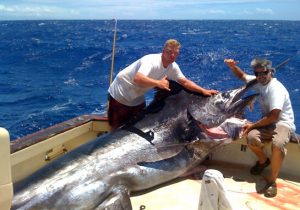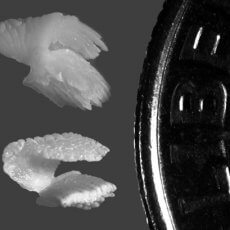We now know a little bit more about the massive marlin that was caught off Hawaii nearly a decade ago. On September 1, 2009, three anglers landed a blue marlin (Makaira nigricans) 21 miles south of Honolulu: the fish measured 12.2 feet long and weighed 1,245 pounds. At over 1000 lbs, the blue marlin is also known as a “grander” marlin.

Fish of this size are difficult to study because they are difficult to land in the first place. The captain, crew, fisherman and locals acted quickly to take size measurements and save the head in order to provide the National Marine Fisheries Service with highly sought after data. In the marlin’s head is the key to answering the question of its age—its otoliths, or ear bones (but any calcified hard parts such scales, vertebrae, and fin spines can be used for aging fish). These calcium carbonate structures, also found in humans, are incredibly tiny yet act as a calendar, laying another layer year after year, similar to the rings found within tree stumps. Scientists can use radioactive carbon dating as a time marker to date a point in the otolith and count forward from there.


In the case of this grander blue marlin, the otoliths were found to weigh less than half a single grain of rice, and both could fit on a dime. The Pacific Islands Fisheries Science Center announced last week that they were finally able to age the grander blue marlin, and discovered that it was just 20 years old.
The first reaction is to be surprised by the young age of such a large fish. It means this blue marlin would have to be growing at an astonishing rate each year—however, there is research from young blue marlins that supports a staggering growth rate. The Billfish Foundation (TBF) is working on furthering this research to determine the potential maximum age. Such information will aid in understanding fluctuations in the fishery over time.
TBF will be working with Dr. John Hoolihan from the University of Miami Cooperative Institute for Marine and Atmospheric Sciences, and Dr. Jiangang Luo from the University of Miami Rosenstiel School of Marine & Atmospheric Science to analyze age and growth data from Atlantic blue marlin. Previous samplings have made available the cross sections of anal fin spines from about 1700 blue marlin gathered in Venezuelan and U.S. fisheries. Among this collection are numerous examples of very large, older individuals. The objective of this project is to develop improved growth rate curves and estimates of maximum age to help reduce the level of uncertainty in the stock assessment process.
When it comes to billfish, many questions remain. It is hoped that this research will help answer some questions, which can then be used in proper management.






